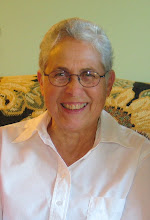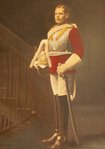In the mean time I'm considering both scanning and transcribing the pages which will be an awesome task! But first, let me describe the book and its contents. The pages are numbered and I wonder if the entries are in chronological order. If so, the first page with an actual date is page 13, a poem titled "Future -- in Darkness", of four verses, each four lines, dated 9th Sept. 1867 and signed "Robt. Raw, Port Royal." This, as I mentioned previously, was the Reverend Robert Raw, a Methodist minister who was known to be stationed in Port Royal between 1863 and 1868, and who had baptized some of the Brown children. The question I ask myself, then, is this: are pages 1 to 12 written prior to 1867? Unfortunately, they are not signed and I have been able to identify only two of the poems in this section, thanks to Google! One on page 10 is titled "Love" and begins:
"Why should I blush to own I love
'Tis love that rules the realms above;
Why should I blush to own to all
That virtue holds my heart in thrall?"
This poem, "To Love", I discovered is by Henry Kirke White,a Nottingham poet born in 1785 who died in 1806. Here is his portrait.
 The other poem I was able to identify is titled "Italian Song", and is five stanzas of ten lines each. It comes from a book by William Henry Giles Kingston,(1814-1880) titled The Pirate of the Mediterranean, and is actually headed "Nina's Song". Kingston was born in London and wrote tales for boys, and spent most of his youth in Oporto, Portugal. To be honest, I never heard of either of these writers and one would have to guess that their fame has long since died out, but they must have been still popular when these poems were written in the commonplace book.
The other poem I was able to identify is titled "Italian Song", and is five stanzas of ten lines each. It comes from a book by William Henry Giles Kingston,(1814-1880) titled The Pirate of the Mediterranean, and is actually headed "Nina's Song". Kingston was born in London and wrote tales for boys, and spent most of his youth in Oporto, Portugal. To be honest, I never heard of either of these writers and one would have to guess that their fame has long since died out, but they must have been still popular when these poems were written in the commonplace book. The next poem that I identified was actually written by an author whose name I recognized, Felicia Hemans, and was so indicated in the book. It was "The Bride's Lament" and is actually titled "The Bride of the Greek Isles", originally published in 1825 in New Monthly Magazine.

Felicia Hemans (1793-1835), born Felicia Dorothea Brown, was an English poet no longer in vogue. Her one famous poem which many may remember is "Casabianca", the first line of which is:
"The boy stood on the burning deck"
This entry is actually signed, but here again is a mystery. At the bottom of the poem is "Julia, Kingston". Who was Julia? I wish I knew! I'm intrigued by the fact that she clearly indicates she wasn't from Port Royal. Perhaps she was visiting the Brown family.
The entries in the commonplace book are representative of people who knew, understood and loved the literature of their period, some of it well known today, the rest not so much. On page 16 is an excerpt from "The Excursion" by William Wordsworth, followed by four lines of a poem from Drifted Snow Flakes, or Poetical Gatherings from Many Authors by Jane Hamilton Thomas on whom I can find nothing! This short excerpt is signed "Anna". Again, who is Anna? She indicated that the poem was by that prolific author, Anonymous.
Further on I found two verses from "The Corsair" by Byron, then on page 22 a poem in three stanzas, titled "Flora's Feast", which comes from Reunido, and Fugitive Pieces, 1864, by Anna Telluz. I can find nothing on line about Anna Telluz. I wonder if Anne Michaels got the idea for the title of her 1996 novel from the subtitle of this book?
This entry is initialled HDCM, and dated 22/2/71, February 22nd, 1871. On the preceding page is a beautiful illustration by the said HDCM.
 I was able to find out something about this contributor. He was Henry DeClondesley Mitchell, and in the 1878 Kingston Directory he is listed as cashier at the Island Treasury. He was married to Susan Madeline Gully and in 1871 was living at 3 East Street.
I was able to find out something about this contributor. He was Henry DeClondesley Mitchell, and in the 1878 Kingston Directory he is listed as cashier at the Island Treasury. He was married to Susan Madeline Gully and in 1871 was living at 3 East Street. considered the greatest Russian poet before Pushkin. His works were translated by Sir John Bowring, 1792-1872, the fourth Governor of Hong Kong.
considered the greatest Russian poet before Pushkin. His works were translated by Sir John Bowring, 1792-1872, the fourth Governor of Hong Kong.



11 comments:
A heavenly project - heavenly opportunity for heavenly research - Have I overused the term yet?
Fascinating! I really appreciate you going through all this effort in order to know more about this Commonplace Book. There's lots of history and personal story behind all these poems and drawings – if only we could know them all!
My mother told me a story from her girlhood days when reciting poetry was mandatory in school. One boy when he was asked to say a poem managed the first line; "The boy stood on the burning deck", and either having forgotten the rest or being unable to resist, continued in patwa "im bun up!"
That's a great story, Jacqueline, and so typically Jamaican! My memory of that poem, which I also had to memorize and which has now left me, is my Dad's version of it:
"The boy stood on the burning deck,
Eating peanuts by the peck".
I wonder how many people these days remember or know that a peck was an item of measurement ....
Peck...hmm, I've heard that word before, used in the same context, but I have no clue how much.
I used to keep autograph books as a teenager. We would write these silly verses in aech other's books and sign to it. Verses like
Roses are red
violets are blue,
sugar is sweet
and so are you.
Wouldn't you say that social networking (facebook etc) and blogging have a somewhat similar concept?
Yes, in a way Facebook and the other social networking sites are like autograph books, though more impermanent.
I'm giving you the 'peak of art' award, because I'm so wowed by your blog. Do come over and collect.
Mrs Sasso used to beat it into my head.
2 pints make a quart
8 quarts make a peck.
4 pecks make a bushel
I hope I' m right
Hi Tony:
I think you're right. I was trying to remember that rhyme myself. Takes me back to my school days.
Hi - After a small bit of reading, I am absolutely convinced that you should use this research to annotate the commonplace book, and donate the compilation along with the book to the National Library of Jamaica or to some other special collections that focuses on Caribbean history. I can think of a few scholars who would absolutely salivate over this kind of data!
Hello!
I haven't a clue what I'm doing, however the thought of someone has been on my mind. My father. Being curious I decided to research the name Brown. Sadly All i know is that his name is Gerald/Jerald Brown. I learned he was in the Jamaican military, arrived later in Toronto. sometime later he moved to Vancouver and had three children 2 boys and a girl. Looking at your blog make me realize How important it is to know where u come from and who. Brown is a large name WoW, doesnt help much but thank you for doing this research. At least you hve family and extended family. God Bless you
Post a Comment